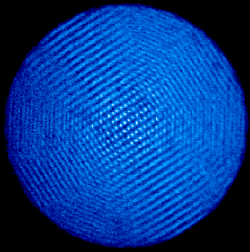Starquakes Rock an Ion Crystal

A crystal disc of super-cool ions could provide a glimpse of the surface of a neutron star, according to research in the 29 October print issue of PRL. When researchers pushed on the disc with a laser, the lattice cracked and slipped rather than spinning smoothly. Astrophysicists believe this brittle behavior could explain why some neutron stars, which have crusts similar to the ion crystal, experience sudden shifts of their surfaces known as starquakes.
When some stars die, they collapse into dense objects called neutron stars. The surface of a neutron star is so tightly packed that the nuclei arrange themselves into a crystalline lattice. Some astrophysicists claim that in certain cases, internal magnetic fields of almost a billion Tesla push against the star’s crust, causing the lattice to suddenly split, slide, and reform. These shifts–commonly called starquakes–result in the sporadic emission of soft gamma rays seen by space-based observatories, according to the theory. But evidence remains inconclusive because researchers cannot directly experiment with the matter of neutron stars.
The new experiment at the National Institute of Standards and Technology (NIST) in Boulder, CO, might provide support for the starquake theory by replicating the conditions on a smaller scale here on earth. The team used laser cooling and magnetic fields to arrange about 15,000 beryllium ions into a disc-shaped crystal lattice. They adjusted the magnetic fields until they had locked the lattice in place–preventing it from spinning. With a second laser beam they applied a torque to the disc. Using a digital camera, the researchers watched as the lattice cracked, rotated slightly, reformed, and became stuck again.
“It’s sort of like studying earthquakes by crushing a pebble,” explains Travis Mitchell, of the University of Delaware, who is a member of the team. The ion disc, they believe, might resemble the star’s crust, while the constant pressure from the laser might approximate the force from massive magnetic fields on its surface. As support for this theory, the team found that the statistics of the sticking and slipping behavior resembled soft gamma-ray emissions from neutron stars.
If these results hold up, they could buttress the starquake hypothesis, says Cole Miller, an astrophysicist at the University of Maryland in College Park. The density of the NIST team’s lattice is much lower than that of a neutron star’s crust, he says, but the similarities in the frequency of slips and their distribution of energies are encouraging. “Having an experimental result like this,” he says, “is probably a point in favor of the magnetic model.”
–Geoff Brumfiel


